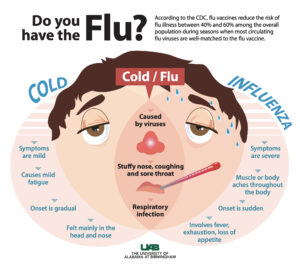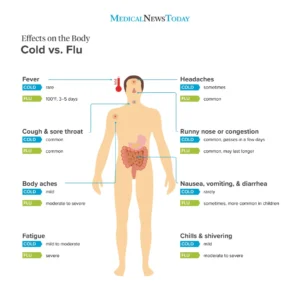What are the reasons of headache and runny nose?
Flu is a contagious respiratory illness caused by influenza viruses that infect the nose, throat, and sometimes the lungs. It can cause mild to severe illness, and at times can lead to death. The best way to prevent flu is by getting a flu vaccine each year.

What are the symptoms of flu?
At first, the flu may seem like a common cold with a runny nose, sneezing and sore throat. Colds usually develop slowly. But the flu tends to come on suddenly. And while a cold can be miserable, you usually feel much worse with the flu.
Common symptoms of the flu include:
- Fever.
- Aching muscles.
- Chills and sweats.
- Headache.
- Dry, persistent cough.
- Shortness of breath.
- Tiredness and weakness.
- Runny or stuffy nose.
- Sore throat.
- Eye pain.
- Vomiting and diarrhea, but this is more common in children than adults.
It’s important to note that not everyone with flu will have a fever.

How Flu Spreads?
Most experts believe that flu viruses spread mainly by tiny droplets made when people with flu cough, sneeze, or talk. These droplets can land in the mouths or noses of people who are nearby. Less often, a person might get flu by touching a surface or object that has flu virus on it and then touching their own mouth, nose or possibly their eyes.
When to see a doctor:
Most people who get the flu can treat themselves at home and often don’t need to see a health care provider.
If you have flu symptoms and are at risk of complications, see your health care provider right away. Taking antiviral medication may shorten the length of your illness and help prevent more-serious problems.
If you have emergency symptoms of the flu, get medical care right away. For adults, emergency symptoms can include:
- Difficulty breathing or shortness of breath.
- Chest pain.
- Ongoing dizziness.
- Seizures.
- Worsening of existing medical conditions.
- Severe weakness or muscle pain.
Emergency symptoms in children can include:
- Difficulty breathing.
- Pale, gray or blue-colored skin, lips or nail beds — depending on skin color.
- Chest pain.
- Dehydration.
- Severe muscle pain.
- Seizures.
- Worsening of existing medical conditions.
Period of transmission:
You may be able to spread flu to someone else before you know you are sick, as well as when you are sick with symptoms.
- People with flu are most contagious in the first 3-4 days after their illness begins.
- Some otherwise healthy adults may be able to infect others beginning. one day before symptoms develop and up to five to seven days after becoming sick.
- Some people, especially young children and people with weakened immune systems, might be able to infect others for an even longer time.
Onset of Symptoms:
The time from when a person is exposed and infected with flu to when symptoms begin is about two days, but can range from about one to four days.
What are the causes of flu?
Influenza viruses travel through the air in droplets when someone with the infection coughs, sneezes or talks. You can inhale the droplets directly. Or you can pick up the germs from an object — such as a telephone or computer keyboard — and then transfer them to your eyes, nose or mouth.
People with the virus are likely contagious from about a day before symptoms appear until about four days after they start. Children and people with weakened immune systems may be contagious for a slightly longer time.
Influenza viruses are constantly changing, with new strains appearing regularly. If you’ve had influenza in the past, your body has already made antibodies to fight that specific strain of the virus. If future influenza viruses are similar to those you’ve encountered before, either by having the disease or by getting vaccinated, those antibodies may prevent infection or lessen its severity. But antibody levels may decline over time.
Also, antibodies against influenza viruses you’ve encountered in the past may not protect you from new influenza strains. New strains can be very different viruses from what you had before.
What are the risk factors for flu?
Factors that may increase your risk of developing the flu or its complications include:
Living or working conditions. People who live or work in facilities with many other residents, such as nursing homes or military barracks, are more likely to develop the flu. People who are staying in the hospital also are at higher risk.
Weakened immune system. Cancer treatments, anti-rejection medications, long-term use of steroids, organ transplant, blood cancer or HIV/AIDS can weaken the immune system. This can make it easier to catch the flu and may increase the risk of developing complications.
Chronic illnesses. Chronic conditions may increase the risk of influenza complications. Examples include asthma and other lung diseases, diabetes, heart disease, nervous system diseases, metabolic disorders, problems with an airway, and kidney, liver or blood disease.
Obesity. People with a body mass index (BMI) of 40 or higher have an increased risk of flu complications.
What complications you see in flu ?
If you’re young and healthy, the flu usually isn’t serious. Although you may feel miserable while you have it, the flu usually goes away in a week or two with no lasting effects. But children and adults at high risk may develop complications that may include:
- Pneumonia.
- Bronchitis.
- Asthma flare-ups.
- Heart problems.
- Ear infections.
- Acute respiratory distress syndrome.

Controlling the spread of infection:
The influenza vaccine isn’t 100% effective, so it’s also important to take several measures to reduce the spread of infection, including:
- Wash your hands. Washing your hands often with soap and water for at least 20 seconds is an effective way to prevent many common infections. Or use alcohol-based hand sanitizers if soap and water aren’t available.
- Avoid touching your face. Avoid touching your eyes, nose and mouth.
- Cover your coughs and sneezes. Cough or sneeze into a tissue or your elbow. Then wash your hands.
- Clean surfaces. Regularly clean often-touched surfaces to prevent spread of infection from touching a surface with the virus on it and then your face.
- Avoid crowds. The flu spreads easily wherever people gather — in child care centers, schools, office buildings, auditoriums and public transportation. By avoiding crowds during peak flu season, you reduce your chances of infection.
Also avoid anyone who is sick. And if you’re sick, stay home for at least 24 hours after your fever is gone so that you lessen your chance of infecting others.

Author


